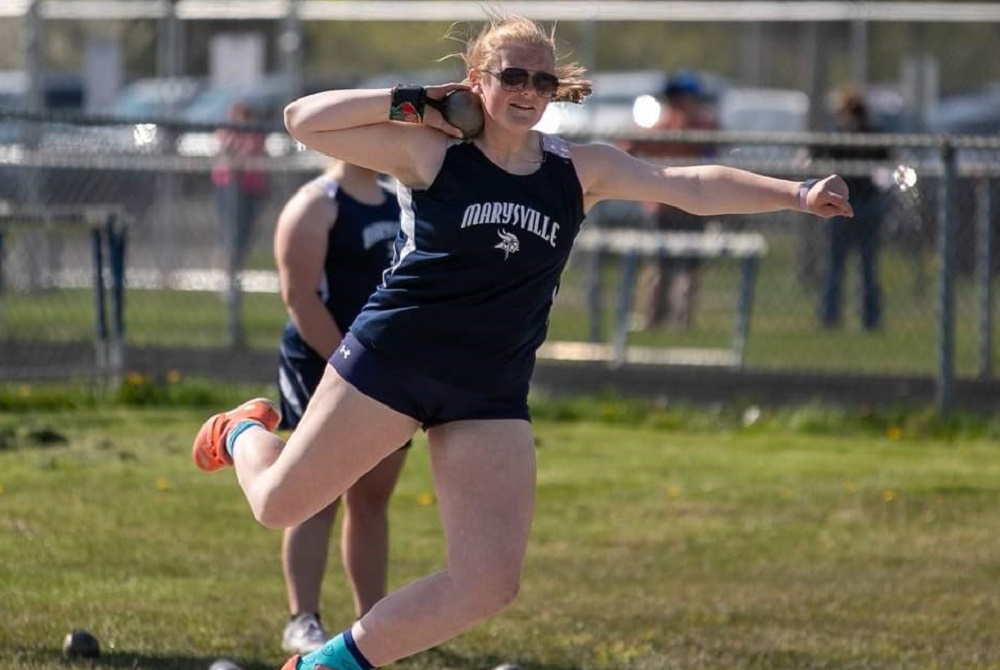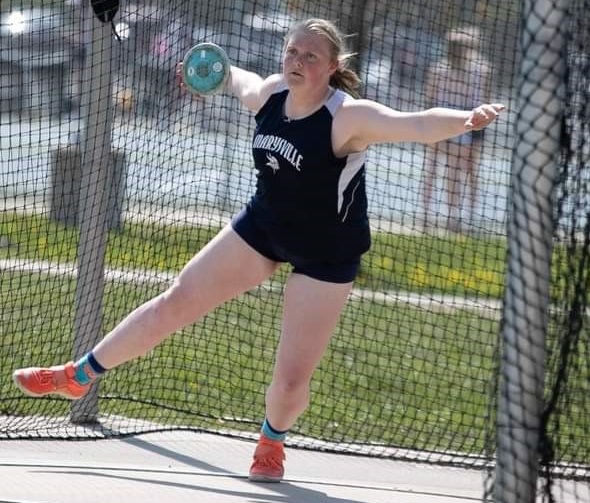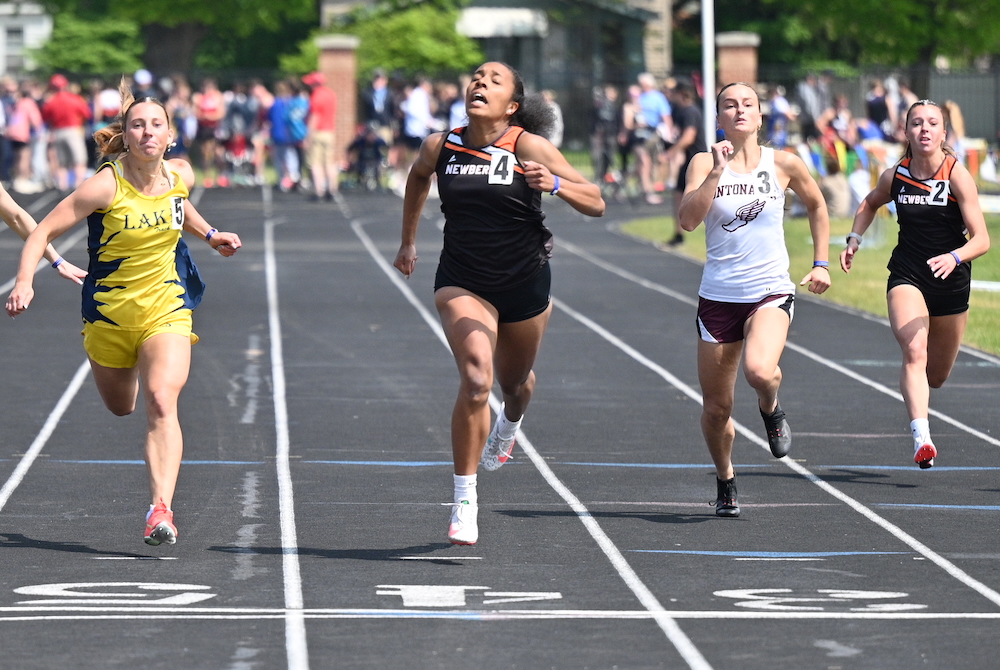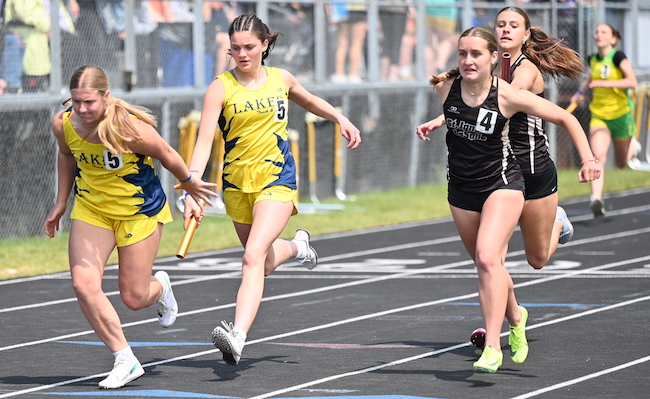
Marysville Thrower Hudson Dancing Into Record Books, Finals Contention
By
Paul Costanzo
Special for MHSAA.com
April 12, 2023
If you see Janae Hudson doing the “Cotton Eye Joe” dance near a shot put or discus pit this spring, don’t be surprised.
 But do pay attention, because a Marysville school record may be about to fall.
But do pay attention, because a Marysville school record may be about to fall.
“I used to get really stressed out before meets, and it would definitely impact my throws,” the Marysville junior said. “I thought that maybe I need a specific routine to not freak me out or anything, and I kind of have it with volleyball, as well. I like to just go off in my own space. When I’m in the hole, I like to kind of just dance around and get all the jitters out before I throw. It’s kind of like a line dance, something I can do in a single space and not bump into other people. I did it last year, and it started to work.”
Hudson, who placed third at the 2022 Lower Peninsula Division 2 Finals in the discus, has already danced and thrown her way into the Marysville record books. She holds the school record in the discus with a throw of 135 feet, 7 inches. Her sights are now set on the shot put record of 40-10, which is about a foot and a half better than her personal best of 39-2¼.
“She’s such a competitor,” Marysville coach Brian Gwisdala said. “She’s already set high expectations for herself. Track is one of those sports where she’s got distances she wants to hit this year. And I think it’s the sign of a mature kid, even though she wants to finish first at states, her big thing right now is she wants that shot put record at the school. She threw 29-2¼ at Saginaw this year. She’s getting there.”
While Hudson showed potential as a freshman, qualifying for the Division 2 Finals and finishing 10th in the shot put, breaking school records certainly wasn’t the expectation at that point.
In fact, when she entered high school, she figured volleyball would be her main focus. While she still plays and is a major contributor for the Vikings volleyball program, throwing has emerged as the sport she wants to pursue collegiately.
 “I was really nervous and timid to actually go to my first track practice,” she said. “But that’s when I fell in love with it. I wasn’t expecting to get this serious with it at the beginning of my freshman year.”
“I was really nervous and timid to actually go to my first track practice,” she said. “But that’s when I fell in love with it. I wasn’t expecting to get this serious with it at the beginning of my freshman year.”
During her freshman year, Hudson began working with throwing coach Michael Hale of Kaizen Throws, and saw immediate results.
She continued to work with Hale through the offseason, and that combined with adding some strength – and a dance routine – helped her take off as a sophomore. In her second season, she added more than two feet to her shot put personal record, and nearly 30 in the discus.
“I think a huge part of it was that she kind of grew into her body,” Gwisdala said. “She’s always been a tall kid, and that coordination and everything caught up to her. I saw it with her in volleyball, too, how much she improved athletically. She really worked hard and put in the time. She throws during the indoor season in the winter. She’s got her private throwing coach that she goes to. All of those factors, and she had the determination and drive to go and do it.”
All of that has put Hudson in a strong position heading into her junior season, not only to further one school record and chase down another, but to improve upon her places at the Division 2 Finals.
Her personal-best discus throw would have tied for first at the 2022 Finals, while her personal best in the shot put would have placed fourth.
“I would love to go to states in both events, and to place first in both would be an ideal situation,” she said. “But if I could finish top three in both, I would walk out happy.”
Helping Hudson chase that ideal situation of winning a Finals title is having watched a teammate do it just two years ago, as Reese Powers won the 400 meters as a junior at the 2021 Division 2 Finals.
“That’s huge,” Gwisdala said. “Just the fact that it was somebody from our school. And it wasn’t someone that necessarily just did one thing, either. Reese and (all-state runner Hannah Fisher) both were multi-sport athletes. The other huge part, and I would say this about Janae right now, too, with Reese was just her work ethic. You would see it every day in practice.”
All of that resonated with Hudson.
“It was a wild moment,” she said. “She’s a junior in high school and can do that; I can do that, too. It would probably mean the world to me.”
 Paul Costanzo served as a sportswriter at The Port Huron Times Herald from 2006-15, including three years as lead sportswriter, and prior to that as sports editor at the Hillsdale Daily News from 2005-06. He can be reached at [email protected] with story ideas for Genesee, Lapeer, St. Clair, Sanilac, Huron, Tuscola, Saginaw, Bay, Arenac, Midland and Gladwin counties.
Paul Costanzo served as a sportswriter at The Port Huron Times Herald from 2006-15, including three years as lead sportswriter, and prior to that as sports editor at the Hillsdale Daily News from 2005-06. He can be reached at [email protected] with story ideas for Genesee, Lapeer, St. Clair, Sanilac, Huron, Tuscola, Saginaw, Bay, Arenac, Midland and Gladwin counties.
PHOTOS (Top) Marysville’s Janae Hudson unwinds while putting the shot during a meet. (Middle) Hudson prepares to let the discus fly. (Photos by Rodney Thomas/Thomas Sports Photography.)

Taylor Sisters, Nwose Key Newberry's Title Run, Jokela Caps Famed Career
By
John Vrancic
Special for MHSAA.com
June 1, 2025
KINGSFORD — The Taylor sisters have been a mainstay for the Newberry girls track & field team throughout this season.
They provided more than half of their team’s scoring here Saturday, helping Newberry gain its first Upper Peninsula Division 3 Finals championship in a decade with 84 points.
Runner-up Lake Linden-Hubbell scored 76 points, and third-place Stephenson had 52.
“This is also the first time our boys and girls won together, which is very exciting,” said Newberry coach Cori Canfield. “We’re going to lose some good seniors, but we’ll have some good freshmen coming in. I’m optimistic about the next 2-3 years. You prepare the kids for this all year, then it’s up to them to execute the plan.”
Junior Samantha Taylor set a U.P. Finals record in the 1,600-meter run in 5:08.47, shaving nearly 6½ seconds off last year’s record time (5:14.9).
Earlier, she established a school record in the 3,200 (11:42), and sophomore Abby Taylor took the 800 (2:26.71).
“I really wanted to try my hardest in the mile, which is my strongest event, and work hard in the other races, and it paid off,” Samantha Taylor said. “This makes me feel more confident in my training and gives me a little momentum going into the cross country season. Being supported by my teammates and coaches is definitely a highlight. Going into my senior year gives me more motivation because it’s my last year.”
She anchored Newberry to a runner-up finish in the 1,600 relay (4:29.54) and Abby Taylor was runner-up in the open 1,600 (5:30.82) and 3,200 (12:35.24). In the 3,200 relay, Abby anchored the third-place finisher (10:38.89).
 Senior teammate Adanne Nwose won the 100 (12.91), and Lake Linden-Hubbell senior Emily Jokela edged Big Bay de Noc freshman Destiny Bleau on a lean for second place (12.95).
Senior teammate Adanne Nwose won the 100 (12.91), and Lake Linden-Hubbell senior Emily Jokela edged Big Bay de Noc freshman Destiny Bleau on a lean for second place (12.95).
“I worked on my starts this week,” Nwose said. “I was really nervous coming in here. I wasn’t supposed to win the 100, which made for added pressure. It was very nerve-wracking. I didn’t think I had won. There were two people to my right. It was crazy close. I’ve been getting under 13 seconds in the past few meets. I would have been very disappointed if I hadn’t gone under 13 today.”
Bleau won the 200 in a meet and school-record 26.02, followed by Rapid River senior Emma Sundling (26.86) and Nwose (26.93).
“I feel pretty good about it,” Bleau said. “It’s a good way to end the season. There were a lot of schools here I hadn’t seen before. I’d say I had good starts. I think this is something I can learn from.”
Her meet record in the 200, topped the previous best (26.36) by Jamie Dompier of Chassell from 2013.
Jokela, a Grand Valley State recruit, became a triple-winner by taking the 100 hurdles (15.98), 300s (46.46) and 400 (59.84).
“I think the competition draws the best out of me,” she said. “They (Newberry) are a bigger school. We’re happy with where we finished. My starts were pretty good. I think this will give me more motivation to work hard for next year.”
Dollar Bay junior Kiera Isaacson won high jump with a school-record leap of 5-4, and sophomore teammate Laila Bell claimed long jump (15-7) and placed third in pole vault (8-0).
Stephenson junior Faith Cappaert took second in the 800 (2:28.6) and third in the 400 (1:02.35) and 1,600 (5:48.01), and anchored the winning 3,200 relay (10:24.35).
Brimley junior Tallulah Slabosheski captured shot put (33-6½) and discus (109-9).
PHOTOS (Top) Newberry's Adanne Nwose (center) wins the 100 dash by four hundredths of a second over Lake Linden Hubbell's Emily Jokela (far left). (Middle) Lake Linden-Hubbell's Ella Schneiderhan hands off the baton to Payton Goldsworthy and St. Ignace's Jillian Fraser hands off to Gwen Kellan in the 800 relay Saturday. St. Ignace went on to win the race with Chloe Bigger and Tayah Shepard also running legs. (Click for more from Cara Kamps/RunMichigan.com.)

